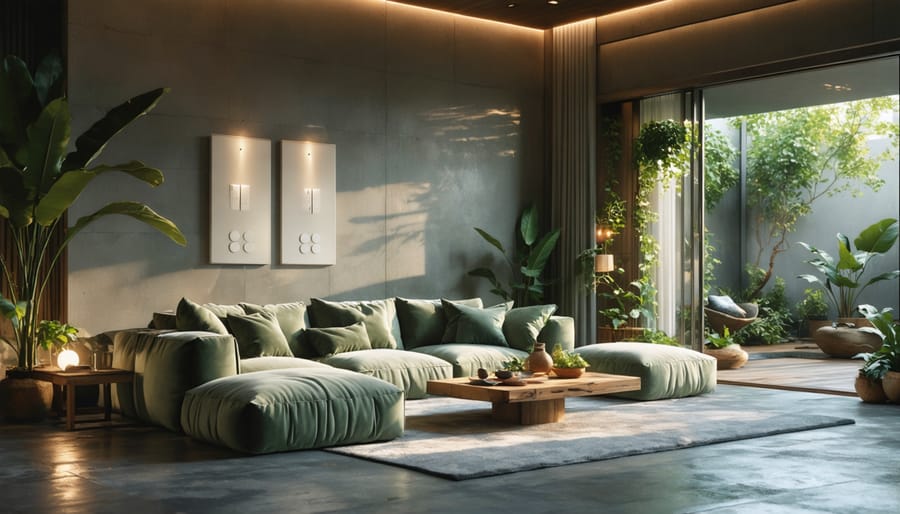Choose energy-efficient windows and doors with low-emissivity coatings, multiple panes, and tight seals to minimize heat loss. Maximize natural lighting and ventilation with strategic window placement, light shelves, solar tubes, and operable skylights. Utilize passive solar design principles like south-facing windows, thermal mass materials, and overhangs for seasonal shading. Incorporate high-performance insulation in walls, attics, and foundations, targeting an R-value of at least R-30 in attics and R-20 in walls. Select Energy Star certified appliances, LED lighting, and smart thermostats to reduce electricity consumption without compromising functionality. Plant deciduous trees on the south and west sides of your home for natural summer shading and winter solar gain. Opt for light-colored, reflective roofing materials like metal, tile, or special coatings to deflect heat and lower cooling loads.
Hack 1: Strategic Window Placement
Strategic window placement is a simple yet effective way to harness the power of natural light in your home, reducing the need for artificial lighting during the day. When planning your window layout, consider the orientation of your house and the path of the sun. South-facing windows generally receive the most consistent sunlight throughout the day, while east and west-facing windows get more intense light in the morning and afternoon, respectively.
To maximize natural light, place larger windows in the rooms where you spend the most time during the day, such as the living room or kitchen. Opt for windows with higher head heights to allow more light to penetrate deeper into the space. If you’re considering window replacements, think about upgrading to energy-efficient models with low-E coatings that help regulate heat transfer while still allowing ample light transmission.
In bedrooms, consider placing windows on two adjacent walls to create a corner of light that bounces off the surfaces, enhancing the overall brightness. Clerestory windows, which are high on the wall near the ceiling, can also be an excellent addition to capture light from multiple angles without compromising privacy.

Hack 2: Insulate, Insulate, Insulate
Proper insulation is one of the most effective ways to reduce energy consumption in your home. By minimizing heat transfer, you can keep your living spaces comfortable year-round while using less energy for heating and cooling. Start by identifying key areas where heat loss occurs, such as walls, attics, basements, and crawl spaces. For walls, consider installing fiberglass batts or blown-in cellulose insulation, ensuring a snug fit between studs. In attics, loose-fill or blown-in insulation works well, as it can easily cover irregular surfaces and hard-to-reach spaces. Remember to seal any air leaks around windows, doors, and electrical outlets before insulating.
When it comes to basements and crawl spaces, rigid foam board insulation is an excellent choice due to its moisture-resistant properties. Install the boards against the foundation walls, and seal the edges with tape to prevent air infiltration. For an extra layer of protection, consider adding a vapor barrier to mitigate moisture issues. Don’t forget about insulating your pipes and ductwork, too! Wrap them with insulation sleeves to minimize heat loss as they travel through unconditioned spaces. By prioritizing proper insulation in these key areas, you’ll create a more energy-efficient home that requires less heating and cooling to maintain a comfortable temperature, ultimately leading to significant savings on your energy bills.

Hack 3: Upgrade to Energy-Efficient Appliances
Investing in Energy Star certified appliances may come with a higher upfront cost, but the long-term savings on your energy bills make it a smart financial decision. These energy-efficient appliances use 10-50% less energy than their conventional counterparts, translating to hundreds of dollars saved annually. When upgrading, prioritize the appliances that consume the most energy, such as refrigerators, washing machines, and dishwashers. An Energy Star certified refrigerator, for example, can save you up to $300 over its lifetime. Similarly, an efficient washing machine can cut your energy use by 25% and water consumption by 45%. While the savings may seem small on a monthly basis, they add up significantly over the life of the appliance. Plus, many utility companies offer rebates and incentives for purchasing Energy Star products, making the upgrade even more attractive. By choosing energy-efficient appliances, you not only reduce your carbon footprint but also enjoy a more comfortable home with lower operating costs.
Hack 4: Harness the Power of Fans
Ceiling fans and portable fans can be your secret weapons in the battle against high AC bills. By strategically placing fans throughout your home, you can create a cooling effect that allows you to raise the thermostat a few degrees without sacrificing comfort. In rooms with high ceilings, running a ceiling fan counterclockwise can push cool air down, making the space feel cooler. Portable fans are perfect for spot cooling in areas where you spend the most time, like your home office or living room.
For maximum efficiency, position ceiling fans 7-9 feet above the floor and 10-12 inches below the ceiling. Aim portable fans toward the center of the room or at a slight upward angle to circulate air effectively. In stuffy rooms, try placing a fan near an open window to draw in fresh, cooler air from outside. Remember to adjust fan settings based on the season – counterclockwise in summer for a direct cooling effect, and clockwise at low speed in winter to gently recirculate warm air. With smart fan placement and usage, you can give your AC a break and still keep your cool.
Hack 5: Embrace Natural Ventilation
Designing your home to take advantage of natural ventilation can significantly reduce your reliance on energy-hungry air conditioning systems. By strategically placing windows and doors, you can create a cross-breeze that naturally cools your living spaces when the weather allows. To maximize airflow, consider installing casement or awning windows, which can be angled to direct the breeze inside. Placing windows on opposite walls or in line with each other encourages air to move through the room more effectively. If you have double-hung windows, open both the top and bottom sashes to create a chimney effect, drawing cool air in from the bottom while pushing warm air out the top. In multi-story homes, a well-placed staircase can act as a natural ventilation shaft, moving air between floors. Remember to keep your windows well-maintained and free of obstructions to ensure optimal airflow. By harnessing the power of natural ventilation, you can enjoy a comfortable home while minimizing your energy consumption and carbon footprint.

Hack 6: Plant Shade Trees
Planting shade trees around your home is a natural and efficient way to reduce cooling costs. Strategically placed trees can block sunlight from hitting your home’s exterior, keeping it cooler and reducing the workload on your air conditioning system. Deciduous trees, which lose their leaves in winter, are ideal as they provide shade in summer but allow sunlight to warm your home in colder months. Some excellent choices include maple, oak, birch, and poplar trees.
For maximum cooling effect, plant trees on the south and west sides of your home, where the sun is most intense. Aim to shade your windows, walls, and roof. Even small trees or shrubs planted near your air conditioner’s outdoor unit can improve its efficiency by keeping it cooler. With proper placement, shade trees can lower the surrounding air temperature by up to 6 degrees Fahrenheit, significantly reducing your home’s cooling needs.
Hack 7: Install Reflective Roofing
Reflective roofing materials are a smart investment for energy-conscious homeowners. These specialized coatings and tiles work by reflecting a significant portion of the sun’s heat away from your home, rather than absorbing it like traditional roofing. This keeps your indoor temperatures more stable and comfortable, reducing the strain on your cooling system during hot months. Experts estimate that reflective roofing can cut cooling costs by up to 20% in warm climates. While professional installation is recommended for the best results, confident DIYers can tackle this project with the right tools and materials. Look for ENERGY STAR certified reflective roofing products, which meet strict performance standards. Whether you opt for a reflective coating or specially designed tiles, you’ll be taking a proactive step towards a more energy-efficient home. Plus, that shiny new roof will be sure to catch the eye of passersby and boost your home’s curb appeal!
By implementing these simple yet effective energy-saving home design hacks, you can make a significant impact on both your energy bills and the environment. Every little bit counts when it comes to reducing energy consumption, and these strategies are easy to adopt without sacrificing comfort or style. Whether you’re a homeowner or renter, you have the power to make a difference. Start small by sealing air leaks or upgrading to energy-efficient appliances, and gradually work your way up to bigger projects like installing solar panels or a cool roof. Not only will you save money in the long run, but you’ll also be doing your part to create a more sustainable future for generations to come. So go ahead, embrace your inner eco-warrior, and transform your home into an energy-saving haven – your wallet and the planet will thank you!





